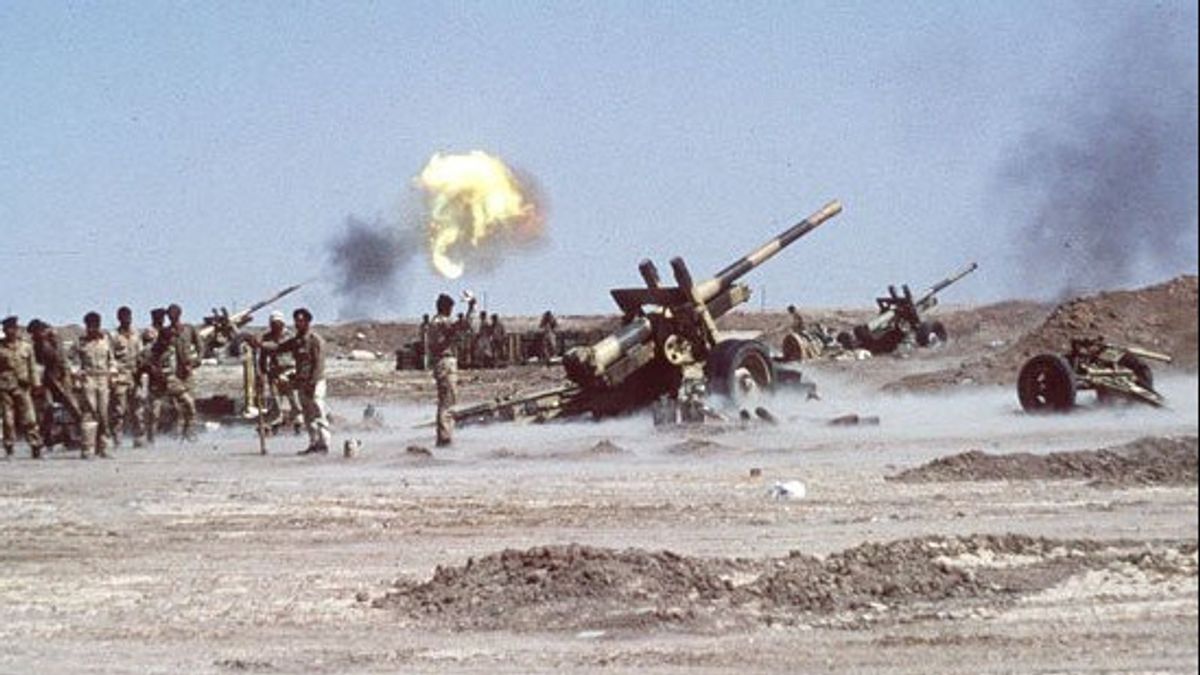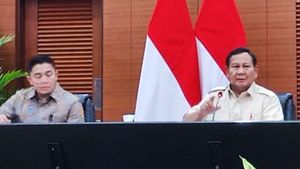JAKARTA - Tensions in the Gulf of Parsia which triggered the war between Iran and Iraq stems from the dispute over the Shatt Al-Arab and Khuzestan regions. Shatt Al-Arab is a 200 kilometer long river formed from the confluence of the Euphrates and Tigris rivers in the city of Al-Qumah, southern Iraq, where the lower reaches of the river lead to the Persian Gulf, the border of Iraq and Iran.
Because of its location on the border, the river has been the subject of dispute since 1975. Iraq has tried to take over the river because it is the country's main route to the sea. The second area that is in dispute between the countries is Khuzestan Province which has oil wealth.
Khuzestan has actually entered Iranian territory. However, in 1969 Iraq claimed the territory as their own. The reason was that Khuzestan had been handed over by the British when Iraq became independent from the colony of that country.
Quoted from the book The Gulf War: The Origins and Implications of the Iraq Iran Conflict by Khadduri Majid, the Iraqi government at that time made an announcement about Khuzestan as their territory via television broadcasts. Iraq also asked its citizens residing in the region to rebel against Iran.
The Islamic revolution in Iran that occurred in 1979 was an important milestone for Iran. At that time Iran succeeded in overthrowing the Pahlavi Empire regime which was considered a puppet of the United States (US). Revolution brought change, namely the Islamic republic system.
The Iranian Revolution received a response among Arab Nationalists and Sunni Muslims. They worry that the revolutionary wave will spread to Arab countries, including Iraq - which adheres to Sunnis - which is adjacent to Iran.
Arjomand, in The Turban for the Crown: The Islamic Revolution in Iran, explains that concern is not without reason. The figure of Ayyatulah Khomeini, the leader of the Iranian revolution, has big ambitions to spread the spirit of revolution to other Arab countries.
Iraq, under the control of Saddam Hussein and the Baath Party was the country most worried. Their interest in becoming the dominant power in the Arab region - by carrying out the concept of Pan-Arabism which is famous since the death of Egyptian President Gamal Abdul Nasser - is threatened.
In mid 1980, there was an assassination attempt on Iraqi Deputy Prime Minister Tariq Aziz. Then Iraq arrested a number of people suspected of being involved in the assassination attempt. Investigations revealed the people to be Shiites.
Saddam Hussein blamed Iran for the incident. He then deported Iranian Shiites and people of mixed Iranian blood. Not enough. On September 17, 1980, Saddam Hussein unilaterally canceled the 1975 Algeria agreement regarding the boundaries of Iraq and Iran which had been agreed by the two countries when Iran was led by Shah Pahlavi.
Gun wars
September 22, 1980, Iraq launched an attack on Iran. The initial step at that time was to take control of the oil-rich strategic area on the border of the two countries. The attack was launched by Saddam Hussein because he saw the internal condition of Iran which was still unstable after the Islamic revolution.
Iraqi fighter jets immediately attacked ten Iranian air bases and destroyed Iranian warplanes. These tactics were learned from Israel's victory over Arab countries in the six-day war. But Iraq failed to destroy the Iranian battleships because they were protected in hangars that had special protection.
Iraq only succeeded in destroying ammunition stores and land transportation routes. A day later Iraq returned to attack. This time the target was a ground attack on Iranian territory which was divided into three points. The first point, taking over Khuzestan and Shatt Al-Arab. Second, control the northern part of Qasr-e Shirin. Finally, send troops to Mehran to fend off Iran's counterattack.
As a result, after the surprise attack Iraq managed to control Iran's territory covering an area of one thousand square kilometers. November 1980, Iraq again launched attacks in the City of Shabadan and Khorramshahr, two cities of strategic importance to Iran. Quoted from the book The Longest War: The Iran-Iraq Military Conflict, in this second attack Iraq received fierce resistance from Pasadan forces, the Iranian Revolutionary Guards.
Iraq won the struggle for territory between tens of thousands of troops from both sides. November 10, 1980, Iraq succeeded in taking control of the City of Shabadan and Khorramshahr. Many have said this victory went well for Iraq. Iraq has succeeded in taking advantage of the weak momentum of Iran's coordination and the difficulty of defense equipment that the country is experiencing.
But Iran did not remain silent. They still fought back even though they lost to the defense equipment. This is reasonable considering that at that time Iraq was one of the countries with a capable military force in the West Asia region after Israel.
Anticipating another Iraqi attack, Iran recruited thousands of people into the Basij (people's army). Although the Basij militias did not have sufficient military or weaponry experience, they did not fear death because of their high belief in their religious ideology.

[/ read_more]
The turning point of the Iranian attack finally materialized in March 1982 through a military operation codenamed "Operation Undeniable Victory". The joint forces between Pasadan and Basij managed to penetrate the front lines of Iraqi forces in the northern and southern parts of Khuzestan province.
In May 1982, Iran succeeded in reclaiming the Khorramshahr region. In the struggle, Iran lost ten thousand troops. Meanwhile, Iraq lost seven thousand troops. With such a large number of deaths, the battle has been described as the bloodiest in the Iraq versus Iran conflict.
Things turned around. Now it is Iran's turn to press Iraq in this battle. In July 1982, Iran launched an attack on the city of Basra under an operation codenamed "Operation Ramadan". The operation was carried out in an effort to take Basra City. Tens of thousands of members of Pasadan and Basij militias carried out suicide attacks by running through minefields to make way for Iranian tanks. From this effort, a small amount of territory was successfully reclaimed from Iraq.
US scandal and involvement of many countriesIran's success in hitting Iraq back raises concerns for the US. US President Ronald Reagan provided defense equipment, technology and intelligence to Iraq. Support for Iraq was also provided by the Soviet Union and the Arab League. Meanwhile, Iran only gets support from Libya and Syria.
However. it turns out that the US is playing two legs. They also provide assistance to Iran in secret. The US helps Iran by selling weapons. The US maneuvers culminated in a scandal known as the "Iran Contra Scandal." One of the top White House officials, Henry Kissinger, revealed that the US felt that Iraq and Iran were equally worthy of support so that there was no domination by the victors in the contested oil-rich region.
In 1984 Iraq returned to attack after receiving assistance from the Super Entetard fighter from France. The aircraft was used to defeat marine military operations at the mouth of the Shatt Al-Arab River to the port of Bushehr.
The aim of the military operation was to block Iranian oil exports so that they agreed to negotiate with the Iraqi side. The Iraqi maneuvers opened a new chapter in the tanker war. In fact, the tanker war has been going on since 1981 when Iraq targeted important points in the ocean, such as Iranian ports and oil refineries.
[/ read_more]

However, in 1984 Iraq attacked Iranian oil carriers. Not wanting to be outdone, Iran retaliated. Iran's counterattack is also a warning that if Iraq continues the tanker war, none of their carriers will be safe. The Iranian offensive got there because Iraqi forces failed to blockade the oil route. Iran is playing fast by first moving routes and ports to Larak Island near the Strait of Hormuz.
The tanker war situation got worse because a neutral country was also affected. Their ship was the target of attack, one of which was Kuwait. The country requested international assistance in 1986. The Soviet Union was the first country to respond to Kuwait's request by sending their warships to escort Kuwaiti oil ships crossing war-prone routes.
This action was also followed by the US in 1987, a step that brought the US deeper into the Iraq versus Iran conflict. Moreover, when the USS Stark was hit by a fighter plane and killed 13 US soldiers.

Quoted from the book Oil, Power and Principle, Iran's Oil Nationalization and Its Aftermath, the US then deployed its naval fleet around the bay to isolate Iran and guard the ships sailing there. Not only that. The US also launched direct attacks on Iran's oil refinery in Rostam.
Then, April 1988, Iranian oil refineries were attacked again. This time along with Iranian warships that were also targeted. The peak of US involvement in the war was when the US ship USS Vincennes shot down an Iranian civilian passenger ship in July 1988. The attack resulted in the deaths of all passengers and crew.
August 20, 1988 marked the end of the eight-year war between the two neighboring countries. Through UN Security Council Resolution 598, the Iraq and Iran wars officially ended, accompanied by the exchange of prisoners of war and resuming diplomatic relations between the two countries.
Both parties recorded suffering losses, both materially, humanity, economically and politically. From a material perspective, the losses suffered by both are estimated at US $ 500 million.
Furthermore, economic development is carried out. It's not that easy, obviously. The two countries must face stunted economic conditions and oil production that has dropped dramatically due to damaged oil fields. Iraqi oil fields were damaged in the Kirkuk, Basra and Fao areas. Meanwhile, the damaged Iranian oil fields were in the Kharg, Rostam and Abadan regions.
The death toll from the Iraqi camp reached 200 thousand. The death toll on the Iranian side was in excess of one million. The large number of Iranian casualties was due to the large number of community troops who went directly to face the battlefield. The political losses suffered after the war were hampered by the wheels of government and the strengthening of US influence in the Persian Gulf.
[/ read_more]
The English, Chinese, Japanese, Arabic, and French versions are automatically generated by the AI. So there may still be inaccuracies in translating, please always see Indonesian as our main language. (system supported by DigitalSiber.id)













